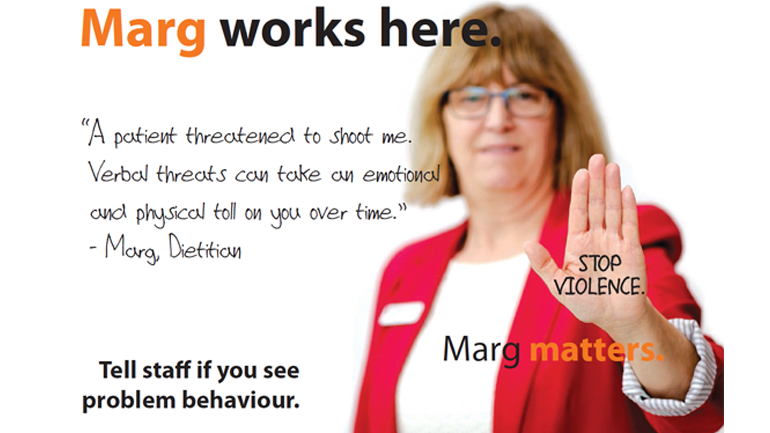
I’m a dietitian. I speak with patients about their diet. Once, I prescribed diabetic meals for a patient. He didn’t like it so he told a nurse he was going to get a gun and shoot me.
I’ve learned you can’t downplay our patients' verbal threats, including yelling and swearing. These behaviours can take an emotional and physical toll on you over time. It helps to debrief with peers after incidents. And sometimes we need to ask the Critical Incident Stress Management Team for support.
I take steps to protect myself from violence. I keep my violence prevention training up-to-date. And I get involved in mock-training drills to practice de-escalating aggressive or violent patients. The training techniques have helped to ensure I get home safe after work each day.
On the job I take note where phone and panic buttons are. I check if the clinic room enables a quick exit without a patient blocking me. In classroom settings with two exits, I place myself close to one of the doors. And when working alone with a patient I inform my co-workers so help is there if I need it.
Code White Teams have our backs - I'm thankful for that. They are a team of trained personnel who respond to codes for aggressive or violent behaviour. They regain control of the room and help to prevent what might otherwise have dire outcomes.
We have strong safety systems in place. But we could do a better job of taking responsibility for communicating risk to our peers. When a patient has the potential for violent outbursts, we need to report it to co-workers so they can take steps. And at times security services need to lend a hand.
Our ALERT system helps communicate potential risks for aggressive behaviours. A purple dot is placed on the patient’s medical record, client chart, Kardex, and room nameplate if they are known to be aggressive. It signals us to read the patient’s care plan for triggers and strategies to prevent violence. Daily I check my patient care plans for ALERTs before approaching my patients.
Family physicians can help too. If their patient can be hostile they need to report it on their referral to us. The first time I take a patient into a clinic room I need to know there is increased risk so I can prepare ahead.
When violent incidents do occur we need to report them. If we don’t report a problem it cannot get fixed. Sometimes after experiencing an incident we struggle and feel "it’s just me," or "it’s part of the job". But it’s not just you. And it’s not part of the job.
Violence in health care is a serious matter. I take the safety of my colleagues to heart.
We each play a part in keeping our environments safe. It's not okay to say “that’s for someone else to do” because an injury could result and affect someone for life. That would be devastating for everyone.
Marg is a dietitian working at Jim Pattison Outpatient Care and Surgery Centre. She is a member of the local Joint Occupational Safety and Health Committee and the Regional Violence Prevention Committee for Fraser Health. Marg has served on the Board of Directors for the Provincial Health Sciences Association for 10 years.
Marg’s story is one in a series where employees reveal their experience of violence to help build compassion for health care providers, educate the public and make our sites safer.
